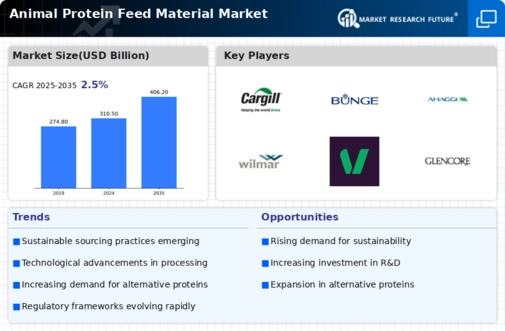Global Trade Dynamics
The Global Animal Protein Feed Material Market Industry is significantly influenced by international trade dynamics. Trade agreements and tariffs can impact the availability and pricing of feed ingredients, affecting overall market stability. Countries that are major exporters of feed materials, such as soybean and corn, play a vital role in meeting global demand. Fluctuations in trade policies can lead to price volatility, which may affect livestock producers and feed manufacturers alike. As the market continues to evolve, understanding these trade dynamics will be essential for stakeholders aiming to navigate the complexities of the global feed supply chain.
Market Growth Projections
The Global Animal Protein Feed Material Market Industry is poised for steady growth, with projections indicating a compound annual growth rate (CAGR) of 2.47% from 2025 to 2035. This growth trajectory reflects the increasing demand for animal protein and the ongoing innovations in feed production. As the market expands, stakeholders are likely to explore new opportunities and strategies to enhance their competitive edge. The anticipated market size of 406.2 USD Billion by 2035 underscores the potential for investment and development within the industry, making it a focal point for future research and business initiatives.
Focus on Sustainable Practices
Sustainability is becoming a pivotal concern within the Global Animal Protein Feed Material Market Industry. Stakeholders are increasingly prioritizing sustainable sourcing of feed ingredients to minimize environmental impact. This shift is driven by consumer demand for ethically produced animal products and regulatory pressures aimed at reducing carbon footprints. As a result, feed manufacturers are exploring alternative protein sources, such as insect meal and algae, which present lower environmental costs. This trend not only aligns with global sustainability goals but also positions the industry for long-term growth, as consumers are more likely to support brands that demonstrate a commitment to sustainable practices.
Regulatory Support and Policies
Government regulations and policies play a crucial role in shaping the Global Animal Protein Feed Material Market Industry. Many countries are implementing supportive measures to enhance food security and promote livestock productivity. For instance, subsidies for feed production and research initiatives aimed at improving feed efficiency are becoming more common. These policies not only encourage investment in the sector but also foster innovation and competitiveness among feed manufacturers. As governments recognize the importance of animal protein in nutrition, the market is expected to benefit from increased funding and resources, further propelling its growth trajectory.
Rising Demand for Animal Protein
The increasing global population and rising disposable incomes are driving the demand for animal protein. As consumers shift towards diets rich in animal-derived products, the Global Animal Protein Feed Material Market Industry is witnessing substantial growth. In 2024, the market is projected to reach 310.5 USD Billion, reflecting a significant uptick in the consumption of meat, dairy, and eggs. This trend is particularly evident in developing regions where urbanization and changing dietary preferences are leading to higher protein consumption. Consequently, feed manufacturers are adapting their offerings to meet the evolving needs of livestock producers, thereby enhancing market dynamics.
Technological Advancements in Feed Production
Innovations in feed production technology are transforming the Global Animal Protein Feed Material Market Industry. Techniques such as precision nutrition and feed additives are enhancing feed efficiency and animal health. These advancements not only optimize feed conversion ratios but also contribute to sustainable livestock production. For instance, the incorporation of probiotics and enzymes in feed formulations is gaining traction, leading to improved growth rates and reduced environmental impact. As these technologies become more accessible, they are likely to drive market growth, with projections indicating a market size of 406.2 USD Billion by 2035, highlighting the importance of innovation in the sector.












